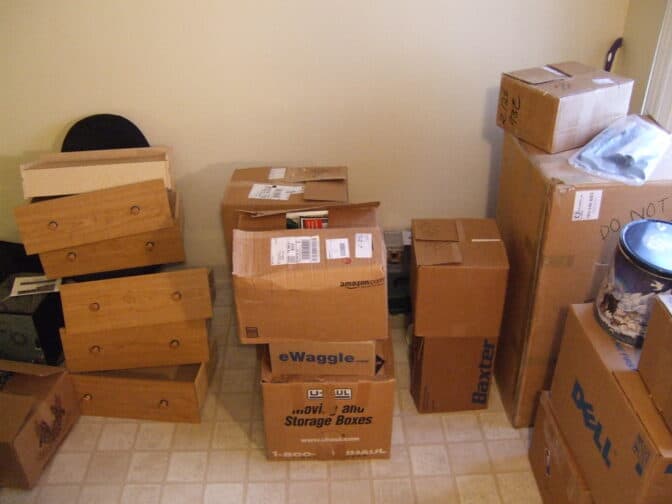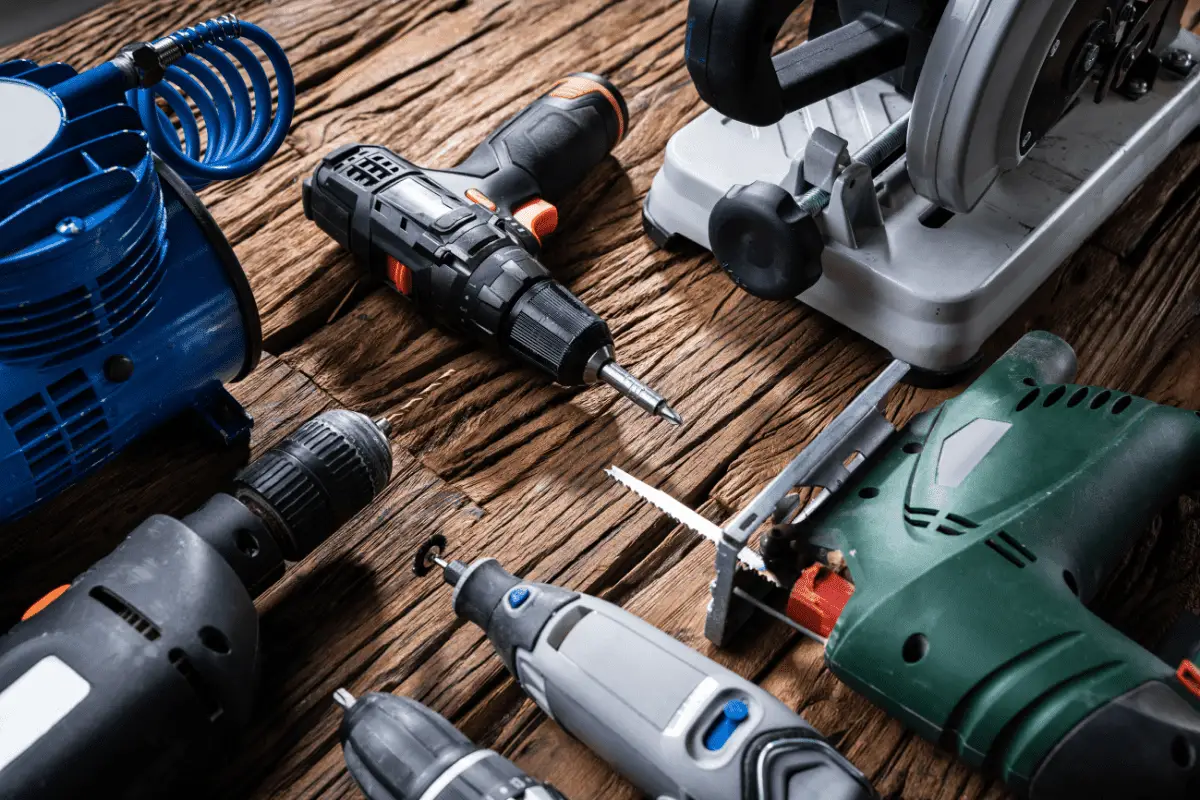Moving is stressful enough without having to worry about all the packing and unpacking. That goes double when it comes to your garage or tool shed.
You think about all those jagged edges and sharp points. Then, you imagine one of them piercing out of the box and injuring someone!
If you’re worried about how to pack power tools for moving, then you’ve come to the right place. We’ll help you minimize clutter and show you the right way to keep all your tools safe and sound.
Let’s get started.
Table of Contents
How to Pack Power Tools for Moving in 6 Steps
Besides being sharp and pointy, power tools are expensive. They need to be treated with care, especially during a move.
So, take your time when packing to reduce the risk of damage and injuries. Read on to learn the easiest way to get your power tools packed and ready to go.
1. Organize Your Tools
The first step to packing anything is to organize, declutter, and purge your stuff. Make four piles: keep, trash, donate, sell.
Start arranging your tools one by one. To stay even more organized, have a pack of heavy-duty garbage bags on hand for the things you don’t want to keep.
Leave behind any tools you were planning on replacing. If you have time, set up a garage sale and offer your tools up for sale. If not, you can always give them to a friend or donate them to charity .
.

In addition, broken and damaged power tools should be disposed of. You can buy new ones once you settle in. Plus, they may hurt you or someone else during transport.
2. Detach Removable or Sharp Parts
Attachments should be removed to avoid damaging the tool. It’s also a way of preventing the power tool from operating on its own during the move.
If there are any batteries, detachable electric cords, or other small attachments, remove them. Then, store them away in a Ziploc bag for safekeeping.
If the cord isn’t detachable, coil it inside its designated storage compartment. Alternatively, you can wrap it around the tool and secure it with a zip-tie or some string.
Try to see if you can detach the sharp blades as well. Remember to work carefully and take your time. Wear some heavy-duty gloves to protect your hands.
Another smart tip is to take a picture of the tool before taking it apart. These pictures will come in handy when it’s time to put it back together and you have no idea where to start.
Once you remove them, clean all the parts by wiping away dirt and residue. Then, wrap them in several layers of bubble wrap, newspapers, or packing sheets. This will protect everyone involved in the move as well as all your tools.
by wiping away dirt and residue. Then, wrap them in several layers of bubble wrap, newspapers, or packing sheets. This will protect everyone involved in the move as well as all your tools.
3. Clean and Drain
Before you start packing, take the time to wipe down each tool. Carefully remove mud, dirt, and grass clippings before wrapping them up.
You’re probably thinking now isn’t the time, but unless you’re in a huge time crunch, now is as good a time as any. Trust us, once you’re in your new home and you start unpacking, you’ll be glad you did.
Taking those extra few minutes to clean your tools will save you hours of work later on. Besides giving you peace of mind, cleaning your tools will protect them from rust and damage.
Do you own gas-powered tools? Then, you should also clean and drain all the liquids from them. These tools are filled with oil and gas, as well as other lubricants. They can easily spill mid-route, leaving all your other stuff drenched in gooey, smelly fuel.
from them. These tools are filled with oil and gas, as well as other lubricants. They can easily spill mid-route, leaving all your other stuff drenched in gooey, smelly fuel.

Besides being messy, gasoline is combustible. So, emptying all the fuel from your tools is a smart thing to do to prevent accidents.
Start a day or two before the move. Find a large container or bucket with a lid and empty all the liquids into it. Once all the tools have been drained, it’s up to you to find a way to dispose of them properly.
4. Dispose of Hazardous Materials
According to the Bureau of Household Goods and Services , there are laws that clearly state what movers can and cannot transport. They’re designed to protect homeowners as well as the movers themselves.
, there are laws that clearly state what movers can and cannot transport. They’re designed to protect homeowners as well as the movers themselves.
Whether you’re hiring movers or doing it all by yourself, you have to figure out which items are considered hazardous in your garage. Check with your municipality, local public works department, local hardware stores before throwing any of them out. They should be able to instruct you on the right way to dispose of power tool liquids and other hazardous materials.
The following are a few examples of the things that can’t be moved:
- Flammable materials, such as aerosol cans, propane tanks, paint, pool chemicals, etc.
- Explosives, such as ammunition and fireworks
- Corrosives, such as batteries with acid
- Unused charcoal
- Anti-freeze
- Fertilizers/pesticides
5. Get Your Packing Supplies Ready
After decluttering your tools and throwing out the things you don’t need, it’s all downhill from here. The following step is to categorize power tools by type and size.
Knowing exactly what you’ll be packing makes it easier to get the right type of packing gear. It’ll also give you an idea of how much packing supplies you’re going to need.
Here are some basic supplies to help you pack power tools for moving:
- Bubble wrap, protective sheets, or old blankets
- Packing peanuts, sometimes referred to as popcorn
- Old newspapers, crumbled up magazines or packing paper
- Packing tape, zip ties, rope, or string
- Sturdy cardboard boxes
- Ziploc bags in different sizes
- A labeling device (or you can use a black permanent marker)
6. Start Packing
Here’s a rundown of some of the different power tools. We’ll walk you through how to pack each type for a safe, no-hassle move.
Hand Tools
Hand tools should stay inside a toolbox. Yet, before you start filling it with tools, first pad the insides for protection.

 . These various packing supplies are often referred to as ‘dunnage.’
. These various packing supplies are often referred to as ‘dunnage.’
Another thing to remember is to test the closing mechanism on the toolbox. Make sure it’s working properly and can handle the bumps and jolts of the move. You don’t want to open the box only to find everything has fallen out of the toolbox. They’ll end up rolling around, getting banged up and damaged.
Some toolboxes don’t come with a lock or don’t close properly. If that’s the case, then get some bubble wrap or an old blanket and wrap it around the toolbox.
These hand-held tools include:
- Clamps
- Screwdrivers
- Hammers
- Files
- Pliers
- Wrenches
- Cutters
Medium-Sized Power Tools
Large power tools, especially those with sharp blades, would be placed inside the box they came in. If you can’t find it, you can buy packing boxes at your nearest post office or shipping service.
If you prefer, you can take the more affordable approach. Get your hands on some newspapers and thick blankets and wrap up all the pointy ends. Then, secure everything in place with packing tape. You can also use string, zip ties, or rope to secure the bundle.
Medium-sized to large power tools include:
- Garden shears
- Hedge trimmers
- Power drills
- Power-operated sanders
- Hand/electric saws
- Power sanders
Long-Handled Power Tools
Tools with long handles, like shovels, brooms, and rakes, don’t have to be boxed individually. What you should do instead is wrap up each one in a blanket or thick sheet.
Then, fold everything in at the ends and secure it with packing tape, rope, or string. Place them in a big box or the moving truck. Either way, make sure you secure them in place with tie-down straps.
Gas-Powered Power Tools
Gas-powered tools are large and bulky so it can be hard trying to wrap them up or box them. Still, if you want, you can place them in a box along with the tools with the long handles. Remember to clean them beforehand and drain out all the liquids as we mentioned above.
Another option is to just place them in the back of the truck. If you do that, however, make sure you secure them with tie-downs to protect them and other items as well.
It’s also a smart idea to cover the spark plugs with heavy-duty cardboard or plenty of packing paper. This will keep them protected during the move.
Some of these power tools include:
- Chain Saws
- Weed trimmers
- Lawnmowers
- Leaf blowers

A Final Note
Taking your things from one home to a new one where you can start fresh is so exciting! It can also be pretty hectic if you don’t know how to pack power tools for moving.
Don’t worry, after reading our post, you’re now an expert on the subject! You know what tools can be moved as well as how to clean and prepare them.
After that, all you need to do is get everything wrapped up, boxed, and ready to go. Knowing the do’s and don’t of moving will keep you and your tools safe during the ride to your new home.

